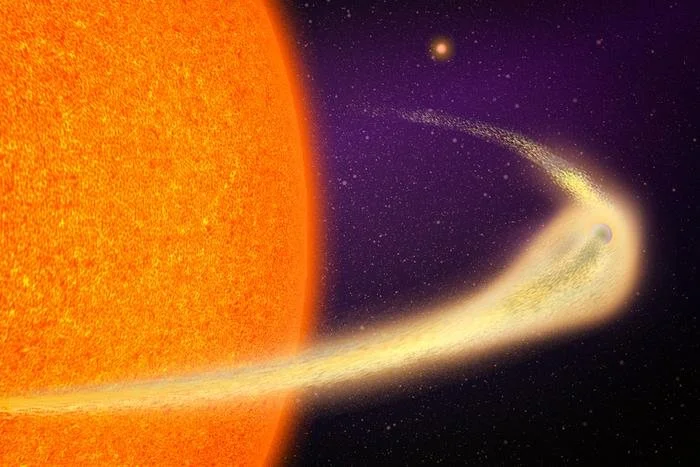#13: Unveiling the Universe: Disintegrating Planets, Growing Black Holes, and Rainy Days on Ancient Mars
CREDIT: JOSE-LUIS OLIVARES, MIT
The Real-World STEM in Class is a weekly newsletter that rounds-up timely STEM news and stories for educators, so educators can easily incorporate real-world STEM conversations into the classroom!
Note from Aspen: In May there are quite a few space themed days, so this will be a special space themed edition to celebrate these days in your classroom:
May 3rd-> Astronomy Day: https://www.astroleague.org/astronomy-day/
May 4th-> May the Fourth Be with You: https://www.starwars.com/star-wars-day
May 5th-9th-> Black Hole Week: https://science.nasa.gov/universe/black-hole-week/
May 7th-> International Day of Planetariums: https://www.ips-planetarium.org/page/AboutIDP
Astronomy
“Astronomers discover a planet that’s rapidly disintegrating, producing a comet-like tail”
Summary: MIT astronomers have discovered a disintegrating exoplanet, BD+05 4868 Ab, about 140 light-years away, that is rapidly losing mass as it orbits extremely close to its star—just 30.5 hours per orbit. Roughly the mass of Mercury, the planet is likely covered in magma due to intense heat and is shedding material at a rate equivalent to one Mount Everest per orbit, forming a massive, comet-like tail of minerals stretching up to 9 million kilometers. Detected by NASA’s TESS mission, its irregular transit signal hinted at this tail, which is composed of evaporated surface minerals rather than gas or ice. Scientists estimate the planet will disintegrate completely in 1–2 million years. BD+05 4868 Ab is now one of only four known crumbling exoplanets, and its dramatic evaporation makes it a prime target for future study with the James Webb Space Telescope to uncover its mineral composition and better understand the diversity of rocky worlds beyond our solar system.
Article Link: https://www.eurekalert.org/news-releases/1081038
Holiday Connection: Astronomy Day
Classroom Connection:
Design an Exoplanet: https://www.teacherspayteachers.com/Product/Design-an-Exoplanet-Astronomy-Project-7469289?st=95c4640d74579995a2db733dbc0607f6
Seeing Starlight: https://science.nasa.gov/wp-content/uploads/2024/08/seeingstarlightmadscience-8-11-21.pdf
Pipe cleaner Constellations: https://www.123homeschool4me.com/pipe-cleaner-constellations_61/
Black Holes
“James Webb Space Telescope finds a wild black hole growth spurt in galaxies at 'cosmic noon'”
Summary: Astronomers from the University of Kansas have used the James Webb Space Telescope (JWST) to study galaxies from over 10 billion years ago during “cosmic noon,” a peak period of star formation 2–3 billion years after the Big Bang. Using mid-infrared observations in the MEGA survey, the team peered through thick cosmic dust to detect galaxies harboring rapidly growing supermassive black holes, or active galactic nuclei (AGNs). These dusty, starbursting galaxies, found in the Extended Groth Strip near Ursa Major, may be ancestors of modern galaxies like the Milky Way. The JWST's powerful infrared capabilities allowed researchers to analyze galaxy structure, star formation rates, and black hole growth previously hidden by dust. The KU team is currently processing and analyzing a vast dataset—67 hours of JWST observations with more to come—offering KU students exclusive early access before the data becomes publicly available.
Holiday Connection: Black Hole Week
Classroom connection:
Model of a Black Hole: https://www.unawe.org/static/archives/activities/pdf/eu-unawe1308.pdf
Paper Circuits: https://chandra.harvard.edu/blackhole/images/circuit_activity.pdf
Beyond Black Holes: https://www.crayola.com.au/for-educators/lesson-plans/lesson-plan/beyond-black-holes/
Mars
"Scientists find subtle clues ancient Mars had rainy days, too"
Summary: New research suggests that ancient Mars was warmer and wetter than previously believed, with rain and snow likely playing a major role in shaping its landscape. Using computer simulations, geologists from the University of Colorado Boulder found that the planet's extensive network of river valleys and lakebeds, such as the delta explored by NASA's Perseverance rover in Jezero Crater, aligns better with a climate that included precipitation rather than just melting ice. The study, published in the Journal of Geophysical Research: Planets, challenges the long-standing view that early Mars was mostly frozen. Simulations showed that valleys formed across various elevations under a precipitation-driven climate, whereas melting ice would only create valleys near the highlands. While modern Mars occasionally sees snowfall, evidence of ancient widespread rain remains key to explaining large features like scattered boulders in Martian deltas—suggesting deep, powerful rivers once flowed across the Red Planet billions of years ago.
Article Link: https://mashable.com/article/ancient-mars-rain-snow-evidence
Classroom connection:
Build a community on Mars: https://www.marssociety.ca/the-mars-explorer-program/build-a-community-on-mars/
Explore Mars: Inside and Out!: https://www.lpi.usra.edu/education/explore/mars/
Mars Perseverance Parachute Coding Activity: https://www.nasa.gov/wp-content/uploads/2021/03/mars-perseverance-parachute-coding-activity.pdf
Design a Rover: https://www.uaf.edu/museum/education/educators/heliophysics-aurora-outre/activities/pdfs/Design-A-Rover.pdf
⭐ Bonus Activity Ideas:
Paper Cup Planetarium: https://www.calacademy.org/educators/lesson-plans/paper-cup-planetarium)
May the Fourth and Force Be With You Light Up Circuit: https://leftbraincraftbrain.com/light-up-may-the-fourth-be-with-you-cards/
Thanks for reading and see you next week! If you found this newsletter insightful, please share with a fellow educator.
Need support when it comes to STEM Education? Here are 3 ways I can help:
Download my free STEM Professional Posters here
I'm a STEM Education Consultant who creates and designs custom STEM curriculum, programming and experiences- making STEM simple, so you can make an impact. Want my eyes on your business? Enquire here
Bring Aspen to speak at your event or school! Enquire here
